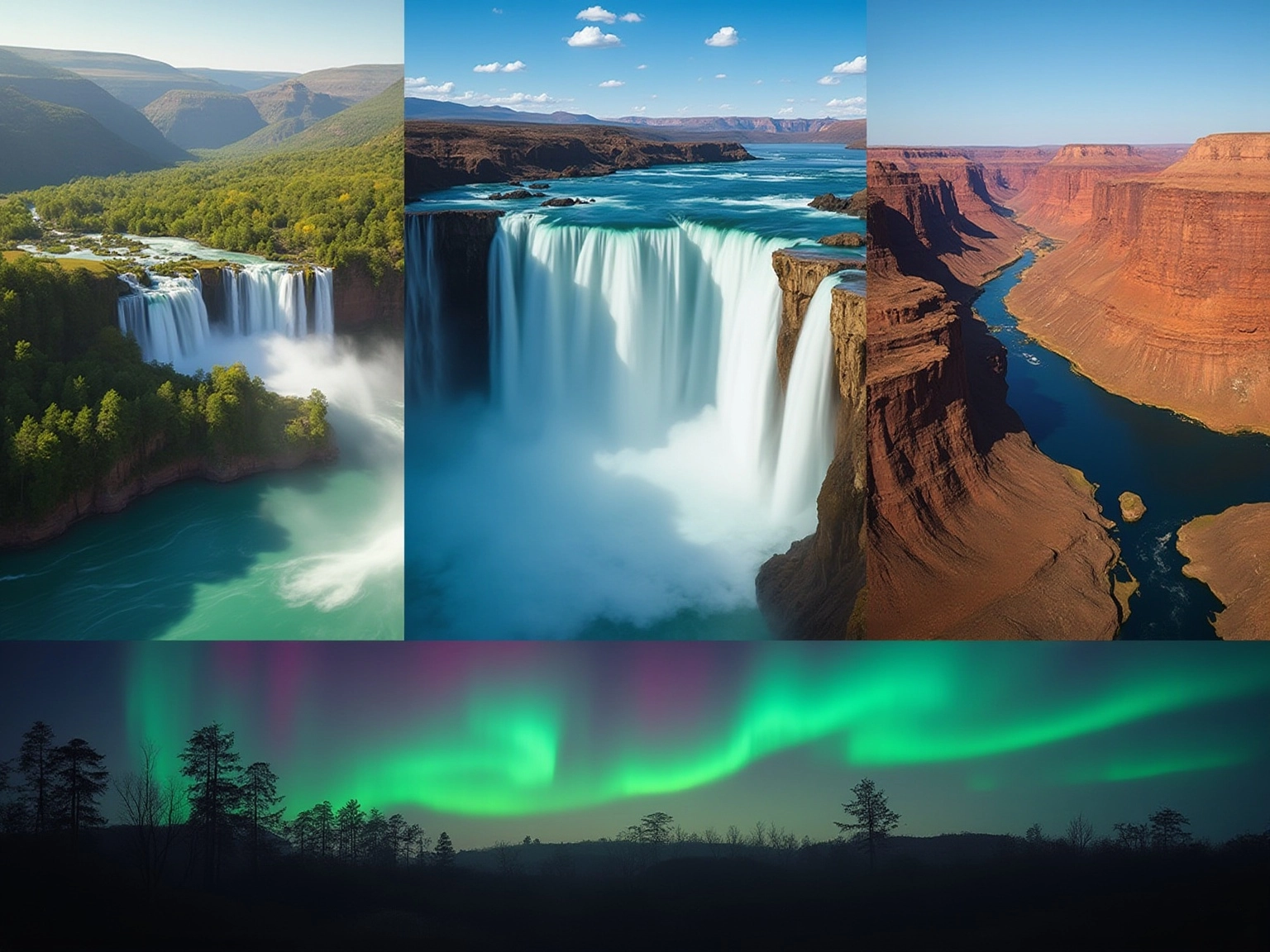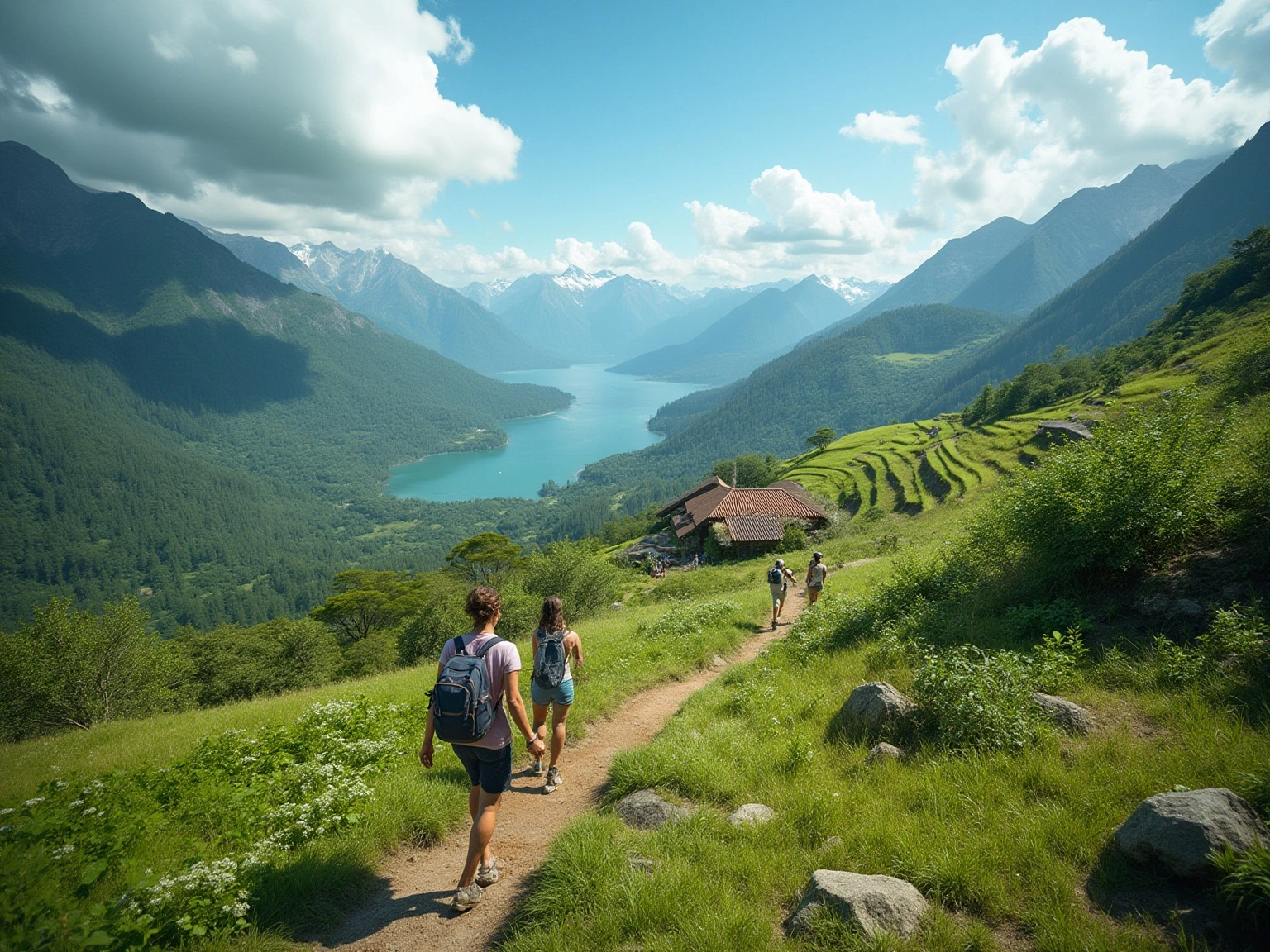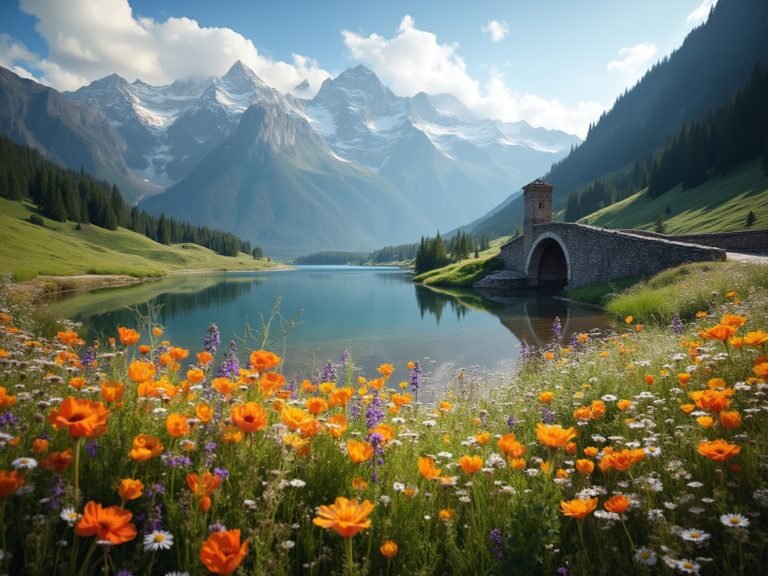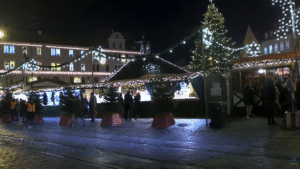Overview
This article shines a light on the most beautiful places to visit around the globe! It emphasizes that beauty in travel is subjective, shaped by your personal experiences, culture, and aesthetics. Picture this: iconic landmarks, breathtaking natural wonders, and vibrant cultural cities await you! These destinations not only connect you to history and nature but also immerse you in local traditions, enriching your travel experiences in ways you might not have imagined. So, are you ready to discover something new?
Key Highlights:
- Beauty in travel is subjective, influenced by personal experiences, culture, and aesthetics.
- 25% of U.S. travelers seek new experiences monthly, showing beauty’s role in travel decisions.
- Younger travelers prioritize unique activities and cultural immersion; older travelers focus on comfort and value.
- Iconic landmarks like the Eiffel Tower, Great Wall, and Taj Mahal attract millions, connecting visitors to history and culture.
- Natural wonders such as the Grand Canyon and Northern Lights showcase Earth’s beauty and geological significance.
- Cultural cities like Florence and Kyoto offer rich artistic heritage and immersive local experiences.
- Global tourism is growing, with a focus on authentic experiences and cultural connections.
- Sustainable travel practices are increasingly prioritized, with 55% of tourists opting for eco-friendly options in 2022.
- Engaging with local cultures through festivals and traditions enhances travel fulfillment.
- Creating a personalized bucket list of beautiful destinations encourages exploration and meaningful travel.
Introduction
In a world filled with breathtaking landscapes, rich cultural tapestries, and awe-inspiring architecture, the allure of beautiful destinations captivates travelers from every corner of the globe. Each journey is a unique opportunity for you to connect with the essence of a place, shaped by personal experiences and cultural narratives that define its beauty. From the serene beaches of the Maldives to the vibrant streets of Kyoto, the quest for aesthetic appreciation goes beyond mere sightseeing; it invites you to engage deeply with local traditions and the stories behind iconic landmarks. As you seek authentic experiences, understanding the multifaceted nature of beauty in travel becomes essential. This exploration dives into the various dimensions of beauty found across the world, encouraging a deeper connection with the destinations that inspire your wanderlust.
Understanding the Allure of Beautiful Destinations
The perception of beauty in places to visit is inherently subjective, shaped by your individual experiences, cultural background, and personal aesthetic preferences. What makes a location beautiful? Think breathtaking landscapes, distinctive architecture, and the vibrant pulse of local cultures! For instance, the tranquil beaches of the Maldives beckon you to relax and unwind, while the towering peaks of Patagonia ignite your sense of adventure and exploration.
Did you know that research shows 25% of U.S. travelers actively seek out new opportunities at least once a month? This highlights how beauty plays a crucial role in their decision-making process. Interestingly, age groups exhibit notable differences in destination selection criteria. Younger travelers often prioritize unique activities and cultural immersion, while older travelers might focus more on comfort and value for money. Private sector employees, too, tend to look for value alongside aesthetic appeal.
Your personal encounters in beautiful places significantly shape your perception of beauty. Imagine enjoying a memorable sunset over Santorini; you might find that island to be a stunning destination. Conversely, someone else might be captivated by Florence’s artistic heritage after a transformative visit. These experiences not only refine your tastes but also broaden your understanding of beauty, making every journey a beautiful place to visit.
As Ray Bradbury wisely noted, “Half of the fun of travel is the aesthetic of lostness.” This sentiment resonates with The Design Tourist’s mission to foster deeper connections with destinations through expert storytelling and practical advice. By recognizing how personal experiences intertwine with the inherent beauty of locations, you can make more informed choices about which beautiful places to visit that align with your desire for connection and aesthetic appreciation.
To enhance your travel experiences, why not share your adventures on social media platforms like Facebook, Twitter, and Instagram? Engaging with a community of fellow design enthusiasts can spark inspiration and provide valuable tips for your next journey. And when it comes to capturing those unique moments, remember to plan your photography sessions during late spring or early autumn for the best lighting and fewer crowds.
Incorporating local culture through traditional attire or props can add a personal touch to your photos, making them even more memorable. Just be sure to check local regulations regarding photography permits, as many national parks require them for professional photography. Embrace the beauty of your travels—each destination can be a beautiful place to visit! Share your stories with the world!
Iconic Landmarks: The Pinnacles of Beauty
Iconic landmarks like the Eiffel Tower in Paris, the Great Wall of China, and the Taj Mahal in India are not just visually stunning; they are also steeped in history and significance. Each year, millions flock to these sites—did you know the Eiffel Tower alone welcomes about 6 million guests annually? Its enduring appeal is truly remarkable! The Great Wall, stretching over 13,000 miles, is a marvel of ancient engineering, attracting around 10 million visitors each year. And then there’s the Taj Mahal, a UNESCO World Heritage site, which sees about 7 to 8 million visitors, standing as a symbol of love and architectural brilliance.
These landmarks offer you a profound connection to the past, allowing you to appreciate the artistic and engineering feats of their respective cultures. The Eiffel Tower, completed in 1889, faced its share of criticism but has since become a beloved symbol of Paris, representing innovation and romance. Similarly, the Taj Mahal, built in the 17th century as a mausoleum for Mumtaz Mahal, embodies the pinnacle of Mughal architecture and serves as a poignant reminder of enduring love.
But the significance of these sites goes beyond their physical beauty. Historians emphasize that visiting such landmarks enhances your journey, helping you gain a deeper understanding of the cultural narratives that shape our world. For instance, the Great Wall not only represents China’s historical fortifications but also symbolizes the resilience and ingenuity of its people.
When you visit these iconic sites, guided tours often delve into their rich histories, enhancing your appreciation for the artistry involved in their creation. Engaging with local guides can reveal the fascinating stories behind these structures, transforming a simple visit into a meaningful journey through time and culture. As adventure lovers like you seek genuine encounters, the allure of these landmarks continues to inspire discovery and connection to the rich tapestry of human history.
With the growing enthusiasm for exploration—evidenced by the National Park Service’s report of a record 331.9 million recreation visits in 2024—it’s clear that iconic landmarks are becoming increasingly significant in the tourism landscape. This trend reflects a broader desire for authentic interactions that connect you to the cultural and historical narratives of the places you visit. As travel journalist Karen LeBlanc, host of The Design Tourist, aptly states, “By combining expert storytelling with practical travel advice, The Design Tourist empowers readers to explore the world with a creative lens.”
This mission resonates deeply with the opportunities at these iconic sites, where the past and present converge to create unforgettable journeys. Moreover, comparing the 140,954 visits recorded in 1905 to today’s figures illustrates the remarkable growth of tourism at these landmarks, underscoring how effective visitor engagement strategies have enhanced their appeal over time.
Additionally, the immersive creative exploration that starts with authentic accommodations is essential for understanding the narratives of these destinations. By staying in places that reflect local culture and artistry, you can deepen your connection to the stories these landmarks tell, perfectly aligning with the ethos of The Design Tourist.
Natural Wonders: Earth’s Most Stunning Landscapes
Natural wonders like the Grand Canyon, Victoria Falls, and the Northern Lights are beautiful places to visit, mesmerizing travelers with their stunning beauty and unique geological significance. These landscapes, shaped over millions of years, showcase the Earth’s dynamic processes and rich history. Take the Grand Canyon, for instance; its layered rock formations reveal a timeline of geological events, making it a living museum of Earth’s past.
With over 6 million visitors annually, this iconic site attracts nature enthusiasts and serves as a testament to the power of erosion and sedimentation.
Now, let’s talk about Victoria Falls—another breathtaking destination! Renowned for its immense width and the sheer volume of water cascading over its cliffs, this UNESCO World Heritage site draws roughly 1 million visitors each year. They come to witness the awe-inspiring sight and explore the lush rainforest ecosystem surrounding it. The geological processes that formed the falls are equally fascinating, involving the erosion of basalt rock by the Zambezi River, creating a dramatic landscape that captivates all who visit.
And then there are the Northern Lights, or Aurora Borealis, offering a different kind of spectacle. Imagine painting the night sky with vibrant colors! This phenomenon occurs when charged particles from the sun collide with the Earth’s atmosphere, resulting in a breathtaking display that attracts travelers from around the globe. Witnessing the Northern Lights fosters a profound appreciation for our planet’s beauty and fragility, reminding us of the delicate balance of nature.
Environmentalists emphasize the importance of preserving these natural landscapes, not just for their aesthetic value but also for their ecological significance. As Tate Watkins notes, asking overseas tourists who do not support U.S. national parks through taxes to pay a little more to see them is reasonable. This approach could provide additional resources to improve the stewardship of the ‘crown jewels.’ As we explore these wonders, we are reminded of our responsibility to protect them for future generations.
By immersing ourselves in these breathtaking environments, we deepen our connection to the Earth and enrich our travels, making each journey a meaningful exploration of our planet’s natural heritage.

Cultural Gems: Art and Architecture in Beautiful Places
Cultural gems like Florence, Italy, and Kyoto, Japan, are truly beautiful places to visit, thanks to their rich artistic heritage and stunning architecture. Florence, often called the cradle of the Renaissance, dazzles with masterpieces from legendary artists like Michelangelo and Botticelli. Did you know that over 15 million tourists flock to its historic sites each year? They’re drawn by the city’s vibrant tapestry of art and history!
The preservation of its Renaissance architecture plays a significant role in its artistic GDP, showcasing the economic importance of this heritage. On the other hand, Kyoto, with its serene temples and traditional wooden homes, attracts around 50 million visitors annually! People come eager to experience its unique blend of ancient culture and modern life. A recent case study highlights how performance spaces in Kyoto are vital to supporting the city’s artistic economy.
When you travel to these cities, you can connect with local traditions in so many ways—think art exhibitions, culinary delights, and lively festivals! For instance, Kyoto’s annual Gion Matsuri festival is a fantastic opportunity to witness the intricate craftsmanship of local artisans. Plus, local museums offer interactive activities like spinning wheel demonstrations and live Cajun music performances, making your journey even more engaging.
Art historians point out that such immersive experiences not only deepen your appreciation for the destination’s history but also foster a connection with the local community.
As Karen LeBlanc wisely notes, the essence of travel is all about exploring authenticity and creativity, which can be found in every destination’s unique story. Kyoto’s sister city partnerships aim to cultivate a new generation of global citizens who understand diverse traditions and possess a worldwide outlook. By exploring these cultural treasures, you’ll discover beautiful places that reveal the stories shaping each city’s identity—turning your travels into transformative experiences that resonate long after you return home.
This aligns beautifully with The Design Tourist’s mission to blend expert storytelling with practical travel advice, empowering you to appreciate the artistry and culture of the places you explore.
Global Diversity: Beautiful Places Across Continents
From the breathtaking fjords of Norway to the idyllic beaches of Bali, the world is filled with beautiful places just waiting for you to discover! Each continent offers unique encounters that captivate the senses and broaden your perspective. For instance, the vibrant souks of Marrakech provide a sensory overload of colors, sounds, and flavors—immersing you right in the heart of Moroccan culture.
Meanwhile, Bali’s serene rice terraces not only offer picturesque views but also reflect the island’s deep-rooted agricultural traditions and spiritual practices. Visiting these varied places allows you to appreciate the intricate beauty of different cultures and environments, ultimately enhancing your journey.
Did you know that the global tourism sector is flourishing? Statistics show a significant growth rate of 11.1% in business expenditure, highlighting the rising interest in genuine experiences. This trend aligns perfectly with the mission of The Design Tourist blog, which serves as a valuable resource for travelers like you who seek to connect deeply with the places they visit. It transforms ordinary trips into extraordinary journeys through insightful content and unique perspectives.
Moreover, the variety of backgrounds found in beautiful places around the globe is not just a backdrop; it’s a vital part of your travel experience. Engaging with local traditions, cuisines, and artistry fosters a deeper connection to the places you visit. As Zubin Karkaria, Founder & CEO of VFS Global, states, “This report not only highlights the diverse prospects for economic growth, sustainable tourism, and cross-cultural collaboration but also provides valuable insights for governments to formulate policies and offers businesses a well-defined roadmap for expansion in this thriving market.”
This emphasizes the importance of experiencing different cultures for personal growth and understanding in our increasingly interconnected world.
Whether it’s the majestic landscapes of Norway or the vibrant artistic scenes of Bali, each destination is a beautiful place to visit, offering a unique narrative waiting to be explored. By embracing these varied encounters, you can transform your journey into an extraordinary adventure that resonates long after you return home. We invite you to share your journey experiences with us and engage with The Design Tourist community for more creative insights and cultural exploration.
Don’t forget to subscribe to our newsletter for the latest updates and inspiration for your journeys!
Experiencing Beauty: The Role of Local Culture
Experiencing beauty in journeys goes beyond just what you see; it’s about engaging with local cultures and communities. Imagine immersing yourself in traditional festivals, savoring authentic local cuisines, and making connections with residents. These experiences can elevate a trip from ordinary to extraordinary! For instance, when you participate in a tea ceremony in Japan, you not only catch a glimpse of the country’s rich traditions but also develop a deeper appreciation for its cultural nuances.
And let’s not forget about the tango shows in Argentina! Attending one allows you to feel the passionate spirit of the locals, enriching your understanding of the destination’s heritage.
Did you know that 78% of younger millennials prioritize relaxation during their journeys? Yet, they also crave meaningful interactions that enhance their experiences. Interestingly, 58% of millennials are willing to travel alone, showing a desire for personal exploration and connection. Engaging in local traditions can greatly enhance your journey fulfillment. This is reflected in the growing trend of heritage tourism, which is expected to dominate the market in Europe.
This shift highlights how important community involvement is in crafting unforgettable journeys. Local specialists emphasize that connecting with nearby populations not only enriches your experience but also fosters a sense of connection and understanding. By embracing local customs and traditions, you can uncover the true beauty of a destination, transforming your travels into profound explorations of culture and creativity.
To capture these moments, think about incorporating creative props into your photography! Traditional attire or local symbols can add a unique societal touch to your engagement photos. Plus, timing your photography sessions for early mornings or late afternoons can help you avoid crowds and truly capture the essence of the location. As noted by Euromonitor, the sports tourism industry is on the rise, with sales of packages sold via agents expected to increase by 15% through 2025. This trend highlights the growing importance of community involvement in tourism.
By integrating these elements, you can enrich your journeys and foster deeper connections with the places you visit. Exploring the architectural aesthetics of your destinations can also provide additional layers of appreciation. The design and structure of buildings often reflect the cultural heritage of a region. The Design Tourist encourages you to not only engage with local cultures but also to appreciate the artistry in architecture that defines each unique location.
Travel Tips for Visiting the World’s Most Beautiful Places
Thoughtful preparation is key when visiting a beautiful destination to ensure a rewarding experience. Here are some essential travel tips to enhance your journey through the creative lens of travel, inspired by Karen LeBlanc, travel host and writer for The Design Tourist:
- Research Optimal Timing: Investigate the best times to visit each location. This not only helps you dodge the crowds but also allows you to enjoy delightful weather. For instance, spring and fall often bring mild temperatures and fewer tourists in many European cities, giving you a chance for a more authentic experience.
- Pack Wisely: Tailor your packing list to the climate and activities you plan to enjoy. Lightweight, breathable materials are perfect for warmer spots, while layers are essential for cooler climates. And don’t forget those comfy walking shoes! They’re a must for exploring stunning landscapes and architectural marvels—each telling its own story.
- Respect Local Customs: Familiarize yourself with the local customs and etiquette of your destination. Understanding cultural norms not only shows respect but also enriches your travel experience. For example, in many European countries, greeting locals in their native language can create goodwill and open doors to authentic interactions. As noted by Tripadvisor, 33% of English tourists, 55% of Singaporean tourists, and 43% of Australian tourists have opted out of trips due to potential restrictions, highlighting the importance of being aware of local sentiments.
- Embrace Sustainable Practices: Adopt sustainable transportation methods to minimize your environmental impact. This includes reducing waste, choosing eco-friendly accommodations, and supporting local businesses. Participating in sustainable tourism not only helps preserve the beauty of these locations but also deepens your connection to the local culture. The Design Tourist Blog emphasizes how conscious journeys can transform ordinary outings into remarkable adventures.
By following these suggestions, you can enrich your travel experiences and make a positive impact on the places you explore. With 78% of companies expecting an increase in business journeys in 2023, the significance of mindful movement is more important than ever. Embracing these practices ensures that the beauty of our world remains intact for future generations to explore and appreciate, echoing the insights shared by Karen LeBlanc on the importance of authenticity and creativity in travel.
Creating Your Own Bucket List of Beautiful Destinations
Creating a bucket list of beautiful places to visit isn’t just a task; it’s a deeply personal journey that sparks your passion for exploration! Start by thinking about what beauty means to you—whether it’s breathtaking landscapes, vibrant cultural moments, or awe-inspiring architectural wonders. For instance, the lavender fields of Provence offer a sensory delight, while the ancient ruins of Machu Picchu provide a glimpse into a rich historical tapestry.
As you put together your list, keep in mind essential factors like accessibility, budget, and the activities you want to embrace. With millennials expected to prioritize experiences over possessions and projected to have an annual income exceeding $4 trillion by 2030, now is the perfect time to focus on crafting a list that reflects your unique interests and dreams. In fact, 44% of millennials with children have traveled together, illustrating the rising trend of family adventures that create lasting memories.
This process not only helps in planning future trips but also serves as a source of inspiration, encouraging you to seek out authentic, off-the-beaten-path experiences. As Karen LeBlanc, the host of The Design Tourist, points out, every location has a story to tell through its local art, architecture, culture, and craft. By immersing yourself in these narratives, you can turn your aspirations into reality!
By personalizing your destinations list, you ensure that each entry resonates with your sense of beauty and adventure, making every visit meaningful and enriching. Join The Design Tourist community for more insights and inspiration on your journey!
Sustainable Travel: Preserving the Beauty of Our World
Sustainable tourism plays a crucial role in safeguarding the beauty of our planet! You can adopt various eco-friendly practices, like minimizing plastic usage, supporting local economies, and respecting wildlife and natural habitats. For instance, choosing sustainable lodgings not only enhances your journey but also helps preserve the environments that attract travelers.
Did you know that in 2022, a notable 55% of tourists opted for eco-friendly locations over other options? This shift shows a rising consciousness about sustainability when planning trips. Plus, the interest in nature-oriented tourism activities is expected to grow, with 70% of travelers looking forward to more offerings in this area after the pandemic. It’s clear that sustainable tourism practices are vital—not only do they help protect beautiful places, but they also enrich your overall experience!
Corporate management professionals are catching on too; 44% prioritized sustainability in 2023, reflecting a broader commitment to responsible policies. A case study on corporate responsibility in sustainable tourism reveals that companies are beginning to recognize their role in promoting these practices. This further emphasizes the need for eco-friendly options during corporate journeys.
By prioritizing sustainability, you can actively contribute to preserving these stunning locations for future generations. Engaging in conservation efforts and choosing accommodations that emphasize eco-friendly practices are effective ways to ensure that the natural beauty of our world remains intact. As you explore the globe, embracing sustainable tourism isn’t just a choice; it’s a responsibility that enhances your adventures while protecting the places you cherish.
The Design Tourist beautifully merges expert storytelling with practical travel advice, empowering you to make informed choices that align with your values and the preservation of these beautiful destinations. And don’t forget about wellness journeys! Experiences like the Mt. Hakusan Mind & Body Ritual can enhance your travels by promoting holistic well-being while exploring authentic cultural practices.
This approach not only enriches your journey but also fosters a deeper connection to the destinations you visit.

Share Your Favorite Beautiful Places: Join the Conversation
We invite you to share your favorite stunning locations and journeys! Whether it’s a hidden gem you stumbled upon or an iconic landmark that took your breath away, your stories can ignite inspiration in fellow travelers. Interacting with the tourism community is essential; studies indicate that 40% of explorers write reviews about hotels and restaurants after their journeys, emphasizing the significance of shared experiences.
Moreover, with 78% of travelers expressing a desire to stay in eco-friendly accommodations and 35% seeking energy-efficient options, sustainability is becoming a key consideration in trip choices. Join the conversation by commenting below—please include your name, email, and website—and share your adventures on social media! Share this post on Facebook, Twitter, LinkedIn, or Pinterest to inspire others!
As Jeremy Jauncey, founder of Beautiful Destinations, observes, “As we move through 2025, the power dynamic in the tourism industry is undeniably shifting to those who can master social-media-specific content creation.” This highlights the significance of community involvement in storytelling about journeys. Together, we can celebrate the beauty of our world and motivate others to explore the beautiful places that await.
Let’s connect and inspire each other to discover the extraordinary in our travels! And don’t forget to sign up for our newsletter to stay updated with the latest insights from The Design Tourist.
Conclusion
Exploring the world’s beautiful destinations reveals a delightful mix of personal experiences, cultural stories, and the unique charm of each place. From iconic landmarks that tell tales of rich histories to breathtaking natural wonders showcasing Earth’s stunning landscapes, you’re invited to dive deep into the essence of these locations. Your journey becomes more than just a visual feast; it transforms into a meaningful exploration of culture, art, and local traditions.
Embracing local culture is incredibly important! Engaging with communities through festivals, cuisine, and authentic experiences enriches your travels, fostering a sense of connection and understanding. As you prioritize meaningful interactions, the rise of sustainable and responsible tourism reflects a growing awareness of the need to protect these beautiful environments for future generations.
When creating your personal bucket list of destinations, take a moment to reflect on what beauty means to you. Is it serene landscapes, vibrant cultures, or awe-inspiring architecture? This personalized approach not only enhances your travel experiences but also nurtures a deeper appreciation for the stories behind each location.
Ultimately, the quest for beauty in travel invites you on a transformative journey that goes beyond sightseeing. By connecting with the essence of each destination, you can create lasting memories that resonate long after you return home. Engaging with diverse cultures and prioritizing sustainability ensures that the beauty of our world is preserved and celebrated, inspiring future generations to embark on their own adventures.
Frequently Asked Questions
How is the perception of beauty in travel destinations shaped?
The perception of beauty in travel destinations is inherently subjective, influenced by individual experiences, cultural backgrounds, and personal aesthetic preferences.
What factors contribute to a location being considered beautiful?
Factors that contribute to a location’s beauty include breathtaking landscapes, distinctive architecture, and the vibrant pulse of local cultures.
How do different age groups approach destination selection?
Younger travelers often prioritize unique activities and cultural immersion, while older travelers tend to focus more on comfort and value for money.
What role do personal experiences play in shaping one’s perception of beauty?
Personal experiences, such as enjoying a memorable sunset or a transformative visit to a cultural site, significantly shape an individual’s perception of beauty.
What is the significance of iconic landmarks in travel?
Iconic landmarks are visually stunning and steeped in history and significance, providing a profound connection to the past and enhancing the travel experience.
How many visitors do some famous landmarks attract annually?
The Eiffel Tower attracts about 6 million visitors, the Great Wall of China attracts around 10 million visitors, and the Taj Mahal sees about 7 to 8 million visitors each year.
What is the importance of engaging with local guides when visiting landmarks?
Engaging with local guides can reveal fascinating stories behind iconic structures, enhancing appreciation for their artistry and cultural significance.
Why are natural wonders like the Grand Canyon and Victoria Falls considered beautiful?
Natural wonders are mesmerizing due to their stunning beauty and unique geological significance, showcasing the Earth’s dynamic processes and rich history.
What are some key statistics about visitor numbers to natural wonders?
The Grand Canyon attracts over 6 million visitors annually, while Victoria Falls draws roughly 1 million visitors each year.
What environmental considerations are associated with visiting natural landscapes?
Environmentalists emphasize the importance of preserving natural landscapes for their aesthetic and ecological significance, highlighting the responsibility to protect these wonders for future generations.


































